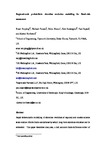Regional-scale probabilistic shoreline evolution modelling for flood-risk assessment
| dc.contributor.author | Stripling, Stuart | |
| dc.contributor.author | Panzeri, M | |
| dc.contributor.author | Blanco, B | |
| dc.contributor.author | Rossington, K | |
| dc.contributor.author | Sayers, P | |
| dc.contributor.author | Borthwick, Alistair | |
| dc.date.accessioned | 2017-02-17T12:47:58Z | |
| dc.date.issued | 2017-03 | |
| dc.identifier.issn | 0378-3839 | |
| dc.identifier.uri | http://hdl.handle.net/10026.1/8524 | |
| dc.description.abstract |
Rapid deterministic modelling of shoreline evolution at regional and coastal-scheme scale enables Monte-Carlo simulations by which long-term shoreline statistics can be estimated. This paper describes UnaLinea, a fast, accurate finite difference solver of the one-line sediment continuity equation. The model is verified for the evolution of an initially straight shoreline of a plane beach subject to regular breaking waves at constant angle of incidence in the presence of either a groyne or a continuous single-point feed of sediment. Grid convergence and stability tests are used to obtain accurate, stable results, with satisfactory computational efficiency. Influences of wave input filtering and event-based sediment loading are considered. The rapid deterministic model is applied to Monte-Carlo simulations of the evolution of the west coast of Calabria, Italy for different scenarios including increased sediment load from a river and selected beach nourishment. The potential role of probabilistic shoreline evolution in regional coastal flood-risk assessment is explored through application to an idealised stretch of the Holderness coastline, U.K., where flood depths and expected damage are estimated for a 1000 year return period event. | |
| dc.format.extent | 129-144 | |
| dc.language | en | |
| dc.language.iso | en | |
| dc.publisher | Elsevier BV | |
| dc.subject | Shoreline evolution | |
| dc.subject | Flood/erosion-risk | |
| dc.subject | Probabilistic modelling | |
| dc.subject | Wave filtering | |
| dc.subject | Regional scale | |
| dc.title | Regional-scale probabilistic shoreline evolution modelling for flood-risk assessment | |
| dc.type | journal-article | |
| dc.type | Journal Article | |
| plymouth.volume | 121 | |
| plymouth.publication-status | Published | |
| plymouth.journal | Coastal Engineering | |
| dc.identifier.doi | 10.1016/j.coastaleng.2016.12.002 | |
| plymouth.organisational-group | /Plymouth | |
| plymouth.organisational-group | /Plymouth/Faculty of Science and Engineering | |
| plymouth.organisational-group | /Plymouth/Faculty of Science and Engineering/School of Engineering, Computing and Mathematics | |
| plymouth.organisational-group | /Plymouth/REF 2021 Researchers by UoA | |
| plymouth.organisational-group | /Plymouth/REF 2021 Researchers by UoA/UoA12 Engineering | |
| plymouth.organisational-group | /Plymouth/Users by role | |
| plymouth.organisational-group | /Plymouth/Users by role/Academics | |
| dcterms.dateAccepted | 2016-12-12 | |
| dc.rights.embargodate | 2018-1-13 | |
| dc.rights.embargoperiod | 12 months | |
| rioxxterms.versionofrecord | 10.1016/j.coastaleng.2016.12.002 | |
| rioxxterms.licenseref.uri | http://www.rioxx.net/licenses/under-embargo-all-rights-reserved | |
| rioxxterms.licenseref.startdate | 2017-03 | |
| rioxxterms.type | Journal Article/Review |


